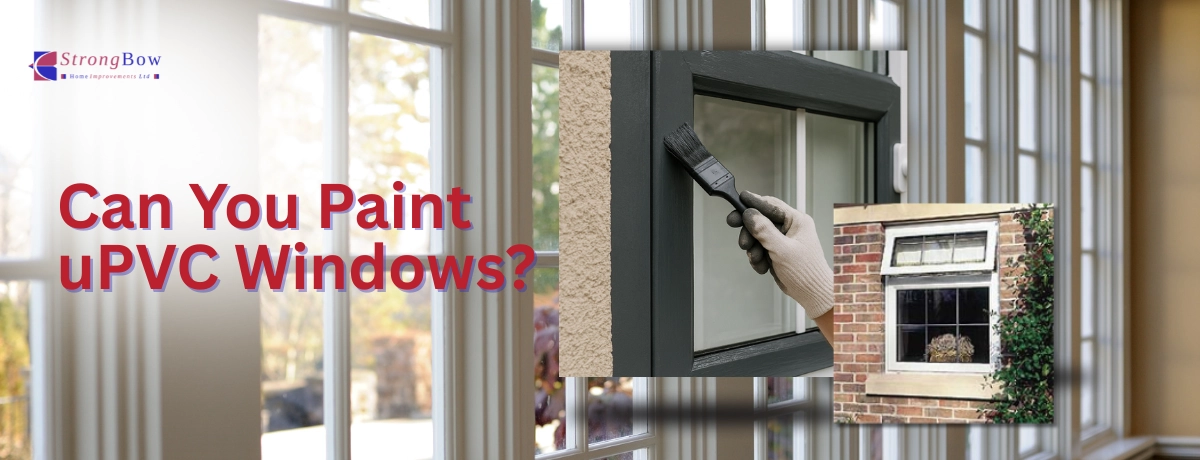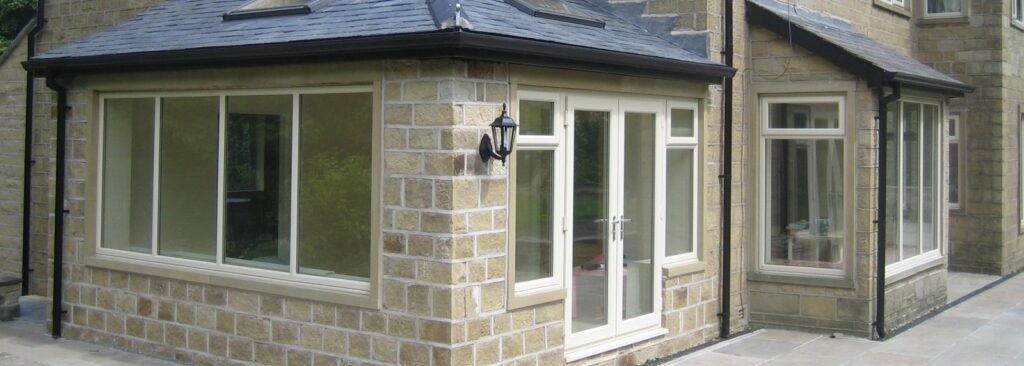How to refresh tired white frames, what paints actually work, and when to call a pro.
Why are people painting uPVC windows?
White uPVC windows once defined the look of modern British homes i.e. neat, practical, and low maintenance.
But with time, these tastes have shifted. Now, many homeowners find those bright plastic frames dated or out of place in today’s greys, greens, and matte finishes. Replacing every window can cost over £10,000, so it’s no surprise more people are asking: can you paint uPVC windows (and get a fresh, factory-like finish without replacing them)?
The short answer is … YES! but only with the right paint for uPVC windows, careful preparation, and patience. Experts advise waiting at least 12 months after installation, since new uPVC continues to release surface resins that stop paint from bonding.
Some manufacturers warn that painting may void your warranty or fade faster on south-facing frames, but thousands of UK homeowners have shown it’s perfectly possible to turn old white uPVC into something stylish and long-lasting.
In this blog, we’ll walk you through every step, from cleaning, sanding, and priming to picking the right products and maintenance tricks to keep your finish looking brand new for years.
Keep reading!
What Prep Work Do You Need Before Painting uPVC Windows?
Prep does most of the heavy lifting. If you rush it, even good paint will peel. Do this first, then the coats will look after themselves.
- Clean the frames. Use sugar soap or mild detergent to lift grease and grime, then rinse and dry.
- Lightly sand. Use 180 to 240 grit paper or a Scotch Brite pad to knock back the sheen without scratching the plastic.
- Wipe away dust. Go over the surface with a tack cloth or a microfibre cloth.
- Mask carefully. Protect glass, seals and surrounding brickwork with quality masking tape such as Frog Tape.
- Remove the hardware. Take off handles and hinges, or tape them up if they must stay on.
- Deal with silicone. Paint will not stick to it, so cut out any visible beads and replace with a paintable acrylic sealant, or choose a compatible paint for PVC window frames.
Take your time here. Once the surface is clean, keyed and dry, painting uPVC becomes simple, and the finish will last.
Do You Really Need Primer Before Painting uPVC Windows?
YES. But DIYers skip this step, and they should not.
Thanks to primers, the colours bond smoothly with the plastic surface, stopping chips and peeling later. Without it, even the best paint for uPVC windows won’t stick easily.
To start, choose a good uPVC primer paint. Options like Zinsser Bulls Eye 1-2-3, Little Greene All Surface Primer (which can be tinted to match your topcoat), and Sandtex PVC-U Primer are pretty popular for trade-grade jobs.
Use a brush or roller and apply one or two thin and even coats. Next, let each coat dry or cure. If it’s outdoors, priming is quite important, but for indoors, though, it’s optional – still worth it if you want a smooth, long-lasting finish.
What’s the Best Type of Paint for uPVC Window Frames in the UK?
Choosing the right product matters as much as your prep work. The smooth plastic surface of uPVC needs paint that can flex with changing weather, resist UV damage, and still look fresh years later. Here’s what to know before you buy paint for uPVC window frames:
| Paint Type | Key Features | Finish / Use |
|---|---|---|
| Acrylic-Based | Flexible, quick-drying, low odour | DIY-friendly; brush or roller |
| Solvent-Based | Strong adhesion, long-term UV defence | Needs ventilation; preferred by pros |
| Vinyl Spray | Smooth “factory” finish | Ideal for confident DIYers or professionals |
| Multi-Surface | Bonds to wood, metal, and plastic | Good for consistent colour across the house |
| Specialist uPVC Paints | Designed for plastic adhesion | Longest lifespan and widest colour range |
Well-reviewed UK options include Bedec MSP, Kolorbond, Zinsser AllCoat, Dulux Weathershield, and Frenchic Al Fresco. These are all neutral, non-promotional examples from real user projects, and you are free to search for more alternatives on your own.
For inspiration, look at painted uPVC windows before and after transformations online; you’ll see why colours like Anthracite Grey (RAL 7016), Sage Green, and Lamp Black remain favourites. These shades stay sharp under UK sunlight and complement both modern and period homes.
How Do You Paint uPVC Windows Step by Step for a Lasting Finish?
Timing and technique can do a lot to make the finish durable and smooth. You can see the best results of your uPVC window painting when you do it on a mild day between 10 and 20°C. Don’t try to do it in direct sunlight or rain.
Here’s how to do it properly:
- Prime first. Apply a thin coat of primer (as outlined above) and let it dry fully.
- Apply the first coat. Use a foam roller or synthetic brush for even coverage; thin layers prevent drips.
- Let it dry. Wait 30–60 minutes, or longer if the manufacturer recommends.
- Add a second coat. Apply a slightly thicker layer to achieve full, consistent colour.
- Optional third coat. Ideal when covering dark colours or using bold tones.
- Allow proper curing. Leave the frames untouched for a few days to harden completely.
- Protect the finish. A gloss or satin topcoat can improve weather resistance.
- Tidy up. Clean brushes and rollers immediately, and seal any leftover paint for future touch-ups.
Also, don’t forget to secure ladders, protect nearby brickwork, and keep pets and children away while the paint cures. With care and the right paint for plastic window frames, you’ll get a smooth, professional-looking result that lasts.
You Might Also Like: Can You Paint a Composite Door?
Is It Better to Paint uPVC Windows Yourself or Hire a Professional?
The difference in finish, cost, and durability between DIYing and calling in professionals is huge. If you’re deciding whether to DIY or hire a pro, here’s how the two compare in terms of time, effort, and overall uPVC window painting cost:
| Aspect | DIY Brushed / Rolled | Professional Spray |
|---|---|---|
| Finish | Slight texture; brush marks possible | Seamless, factory-smooth |
| Cost | Around £100 for materials | £1,200–£1,500 per house |
| Durability | 3–7 years | 8–15 years |
| Time | 2–3 days | 1–2 days |
| Skill Level | Beginner-friendly | Requires specialist equipment |
Tradespeople on different forums agree that professional spraying gives the best, most consistent finish, but it only makes financial sense for full-house projects or when you want a flawless, “new window” look.
For smaller updates, careful DIY with quality paint for plastic windows often strikes the right balance between cost and satisfaction.
Also Read: How Much Is a Composite Front Door?
How Long Does Painted uPVC Last, and What Maintenance Does It Need?
If you’re wondering how durable your paint job will be, here’s the truth: with good preparation and high-quality materials, painted uPVC can last five to ten years before needing a refresh. But, as with most home projects, it depends on how well you care for it.
Clean the frames gently with warm, soapy water and a soft cloth, and never use abrasives or harsh chemicals. When the colour starts to dull, apply a light recoat rather than waiting for peeling or cracking.
Common issues include:
- Peeling caused by poor sanding or silicone residue.
- Cracking from cheap gloss exposed to direct sunlight.
- Warping on dark, south-facing frames without reinforcement.
One can paint PVC windows successfully. But, remember, even the best finish needs maintenance. A well-applied paint for plastic window frames may look like new for years, but the factory-finished uPVC will still require less maintenance.
Is Painting Always the Right Choice or Should You Replace Instead?
Painting can breathe new life into tired, discoloured uPVC, but is it the answer in every case?
NO.
Repainting can create more problems than it solves if your frame is less than a year old, comes under warranty, or already has cracks or warping. Originally, uPVC was meant to be low maintenance, and painting will simply increase your efforts in maintaining it.
That said, for older windows in good condition, a careful clean, sand, prime, and paint routine can make a home look brand new again. It’s a cost-effective and eco-friendly way to modernise your property without full replacement.
We at Strong Bow Home Improvements help homeowners and businesses across Huddersfield and West Yorkshire pick the right solution for their space. Expert repainting advice, supply-only products, or complete replacement with energy-saving uPVC windows and doors – we offer it all!
We are a FENSA Registered Company. All our installations meet the latest building regulations and performance standards, and you get to enjoy peace of mind when it comes to home improvement solutions.
Ready to refresh your home?
Call our friendly team at 0800-0483-352 or 01484-512743 today or request a free, no-obligation quote to see how easily you can upgrade the look and performance of your windows.



